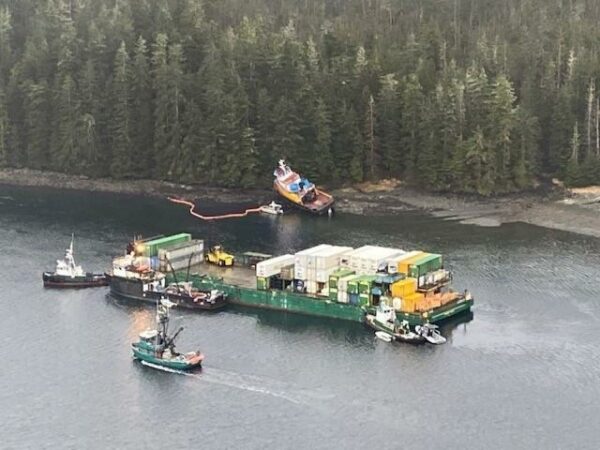
State biologists are looking into how a recent diesel spill 15 miles northwest of Sitka will affect the sac roe herring fishery, which went on two-hour notice Tuesday morning.
The Alaska Department of Fish and Game’s annual pre-season herring meeting on Monday night was punctuated by news of the spill, which occurred early that morning when a tugboat towing an Alaska Marine Lines barge ran aground in Neva Strait.
In the collision, one of the tugboat’s fuel tanks ruptured. The size of the spill remains unknown, but the boat has an overall fuel capacity of around 45,000 gallons, and the ruptured forward tank can hold up to 13,000 gallons.
Sarah Moore is a spokesperson for the Alaska Department of Environmental Conservation. She said response teams were still working to remove fuel from the damaged fuel tank and had successfully patched all of the holes in the tugboat’s hull as of Monday evening.
“One of the big ‘to do’ items for the next couple of days is to remove the tow line from the barge so that the barge can continue on to Sitka,” Moore said. “And then they will continue to focus on recovering the tugboat that is grounded.”
Sitka area management biologist Aaron Dupuis said Fish & Game would begin assessing potential impact on the fishery and subsistence harvest.
“Nets will not go in the water until we have a good handle on where the diesel spill is,” Dupuis said. “Nobody wants to get oil nets, or oil fish or any of that. So yeah, in our aerial survey, and with vessel surveys, we’ll be able to know exactly where the sheen is. And the commercial fishery will not operate in areas that are impacted by this.”
Fisheries biologist Troy Tydingo added that the state has a zero tolerance policy for oil contamination and seafood, and they would not open an area for fishing if there was a risk of contamination.
Dupuis said that as of Monday, the visible sheen had not extended into Olga Strait or into Krestof Sound, where herring openers have occurred in the past. As long as the sheen remained limited to Neva Strait, Dupuis didn’t anticipate it would impact the timing of the fishery.
[Sign up for Alaska Public Media’s daily newsletter to get our top stories delivered to your inbox.]




